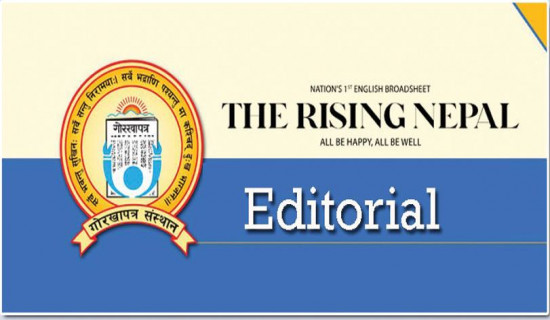- Wednesday, 22 October 2025
Foreign Reserves Rise
Against all odds, Nepal’s economy is showing signs of gradual recovery. A report on the current macroeconomic and financial status, published by the Nepal Rastra Bank (NRB) Tuesday, reveals that the external sector of the economy has improved significantly during the first six months of the current fiscal year 2023/24. Foreign currency reserves, balance of payments, current account and remittance inflows have picked up. This amply shows that measures taken to boost the slackening post-pandemic economy was pragmatic and satisfactory, busting all the rumours that the economy was heading to imminent collapse like that of Sri Lanka.
The NRB’s data also reflects resilience of Nepali economy in the face of internal and external shocks. Last September, Asian Development Bank (ADB) predicted that Nepal’s economy was expected to grow by 4.3 per cent (at market prices) in the fiscal year 2024, up from an estimated growth of 1.9 per cent in FY 2023. This projection is based on flexible monetary policy, moderation in inflation and comfortable foreign reserves.
The NRB’s latest macroeconomic report also corroborates the ADB’s estimate of economic growth. The gross foreign exchange reserves increased by 18 per cent to Rs. 1816.57 billion in mid-January 2024 from Rs. 1539.36 billion in mid-July 2023. This is indeed remarkable achievement as the country had witnessed sharp decline in the foreign reserves due to the constant fall in the inflow of remittances caused by prolonged impact of pandemic in 2021 and 2022. For the least developed countries like Nepal, the foreign reserves play a vital role in ensuring access to global market. They help in maintaining balance of trade and balance of payments (BoP) while stabilising exchange rate, attracting foreign investment, mitigating financial crisis and spurring economic growth.
The country saw the remittance inflow increase by 25.3 per cent to Rs. 733.22 billion in the review period compared to an increase of 24.3 per cent in the same period of the previous year. The remittance of Rs. 120 billion was received in a single month from mid-December 2023 to mid-January 2024 of the current fiscal year. The number of Nepali workers, both institutional and individual, taking first-time approval for foreign employment was 207,970 and taking approval for renew entry was 135,435. Though reliance on the remittance is not good for the country in the long run, it has enabled to reduce the rate of poverty in rural areas. Prudent policy needs to be adopted to divert the remittance in the productive sectors so that gainful jobs are created at home and exodus of youths going abroad will be checked.
The current account remained at a surplus of Rs. 161.62 billion in the review period against a deficit of Rs. 35.57 billion in the same period of the previous year. Similarly, balance of payment remained at a surplus of Rs. 273.52 billion in the review period against a surplus of Rs. 92.15 billion in the same period of the previous year. Capital transfer declined by 30 per cent to Rs. 3.11 billion and net foreign direct investment (FDI) remained positive at Rs. 4.53 billion. Likewise, the y-o-y consumer price inflation moderated to 5.26 per cent in mid-January 2024 compared to 7.26 per cent a year ago. These positive indicators are also encouraging at a time when biting recession is still lingering, with many retailors shutting down their businesses and shifting to other professions or leaving the country.

















